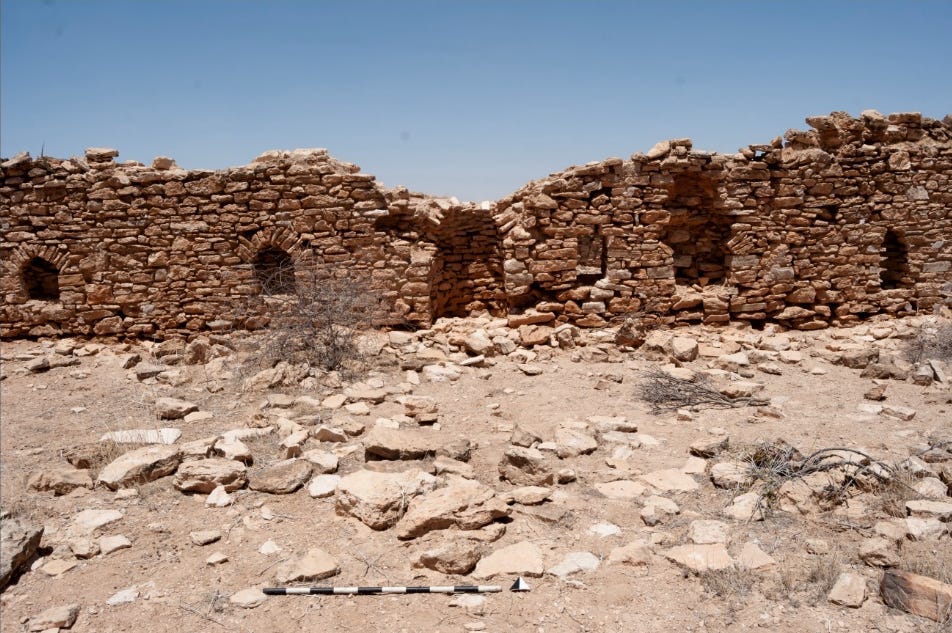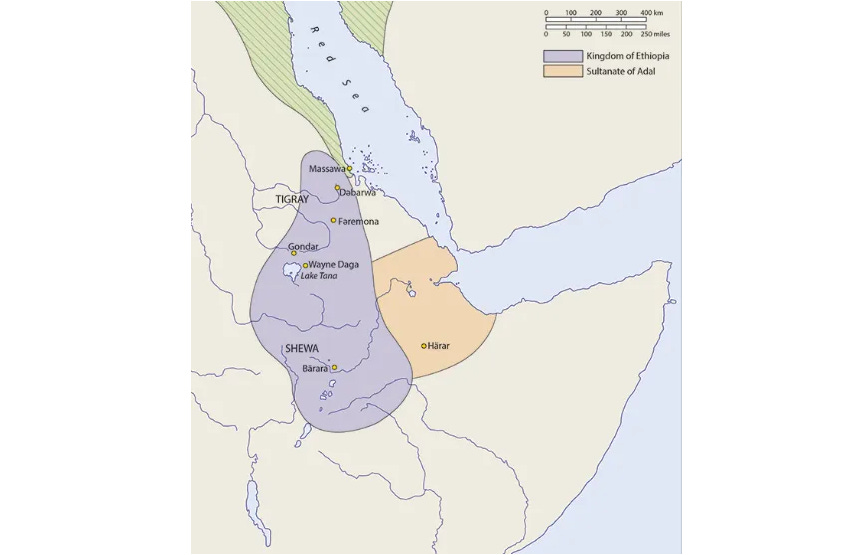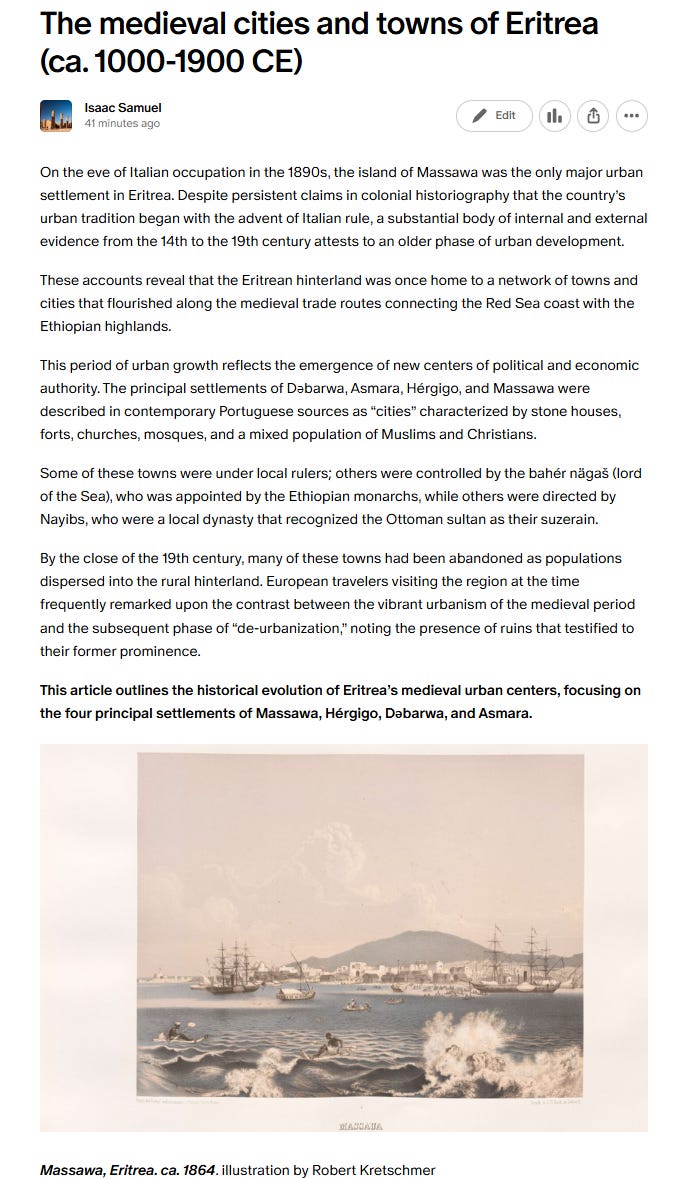Medieval cities in the northern Horn of Africa (1200-1600 CE)
The northern horn of Africa is home to one of the largest concentrations of urban settlements on the continent, many of which are of significant antiquity.
Until recently, studies on the emergence of cities and towns in the northern Horn of Africa have focused on the urban culture of the Aksumite civilization. Its monumental stone palaces and monolithic stelae provide evidence for the indigenous development of nucleated settlements during late antiquity, which were later abandoned during the early Middle Ages.
Although historical traditions suggest that few urban centers existed in medieval Ethiopia before the establishment of a permanent royal capital at Gondar in the 17th century, recent archaeological research has provided evidence for a substantial network of stone cities and towns that flourished along key trade routes linking the Ethiopian highlands with the Red Sea coast, between the 13th and 16th centuries.
These medieval cities were mostly founded in the Muslim polities that emerged on the eastern frontier of the Christian kingdom, in what is today Eastern Ethiopia, Somaliland, Eritrea, and Djibouti. They consisted of dense urban habitats that contained civic buildings, mosques, workshops, houses, and cemeteries whose material culture testifies to the accumulation of wealth and the intensity of trade with the Indian Ocean world.
In the highlands of eastern Ethiopia, the emergence of cities during the late Middle Ages was associated with the kingdom of Ifat (Awfāt), which dominated trade between the interior and the coastal city of Zeila in Somaliland.
Local chronicles and external accounts describe the urban settlements of Ifat as cosmopolitan cities, with “citadels,” “cathedral mosques” and vibrant markets, where one could “find every kind of merchandise that there is in the world, and merchants of all nations, from Morocco, Fez, Bugia, Tunis, Turks, Roumes from Greece, Moors of India, Ormuz and Cairo.”
These textural accounts are corroborated by the archeological record. At least five ruined cities: Asbari, Masal, Rassa Guba, Nora, and Beri-Ifat, have been identified within the former territories of the kingdom of Ifat, all securely dated to the 14th century.
Main mosque at Beri-Ifat, Ethiopia. images by ‘Mission archéologique française, 2010’.
Square house with a wall niche at the site of Nora, Ethiopia. Mission archéologique française, 2008.
Medieval archaeological sites in the northern horn. Map by StateHorn.
Between Ifat and Zeila was the city of Harar, which also emerged during the late Middle Ages in a region dotted with the remains of several stone towns containing palaces, civic buildings, and castle-houses.
The metropolis of Harar was a major intellectual and political capital of several Muslim polities in the region. The walled city, which contained over a hundred shrines and mosques, minted its own currency and, for several centuries, dominated much of the region’s external trade.
Ruins of buildings near Harar, Ethiopia. images by Meftuh S. Abubaker.
In Somaliland, recent archaeological surveys have identified a network of about 30 cities and towns that were founded at the end of the Middle Ages and were associated with the empire of Adal.
Towns such as Abasa, Amud, Fardowsa, and Maduuna contained well-preserved ruins of dry-stone palaces, mosques, houses, and cemeteries. While some were involved in external trade through Zeila, most were agricultural settlements, which were later abandoned and transformed into pilgrimage sites.
Miḥrāb and niches of the Maduuna congregational mosque. image by StateHorn
The Empires of Ethiopia, Adal, and the Ottomans in the 16th century. Map by M. Salvadore.
The development of cities in the medieval northern Horn of Africa was shaped by a complex interplay of economic exchange and political rivalry between the Christian kingdom in the interior and the Muslim polities near the coast.
This dynamic is especially evident in Eritrea, where a chain of towns linked the port town of Massawa to the mainland markets. In this region, power shifted over time between local rulers and regional hegemons, including the empires of Adal, Ethiopia, and the Ottomans.
While it was initially thought that the urban history of Eritrea began with Italian colonialism in the late 19th century, a re-examination of the Historical and archaeological evidence reveals a much older urban tradition, with several medieval towns that were abandoned just before the Italian period.
The history of the medieval cities and towns of Eritrea is the subject of my latest Patreon article. Please subscribe to read more about it here and support this newsletter:










That's were some of my oldest Ancestors were found, they also have links to Oman, Yemen and Bahrain (4469 BC(ANCIENT ETHIOPIA)Total shared SNPs: 235.0-Largest SNP chain:127.0-mtDNA:L3x2a2bY-DNA:E1b1a2b2-Genetic Distance: 103.30865
(Tigray-Oromo-Eritrea-Somali)